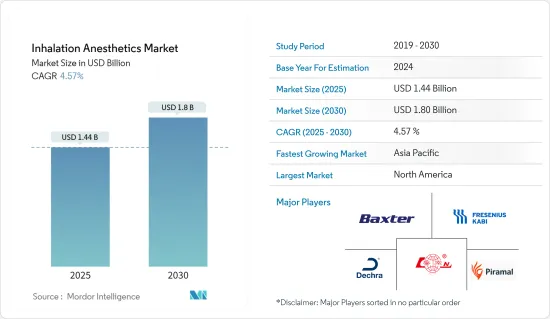PUBLISHER: Mordor Intelligence | PRODUCT CODE: 1685733

PUBLISHER: Mordor Intelligence | PRODUCT CODE: 1685733
Inhalation Anesthetics - Market Share Analysis, Industry Trends & Statistics, Growth Forecasts (2025 - 2030)
The Inhalation Anesthetics Market size is estimated at USD 1.44 billion in 2025, and is expected to reach USD 1.80 billion by 2030, at a CAGR of 4.57% during the forecast period (2025-2030).

The application of inhalation anesthetics for the diagnosis and treatment of COVID-19 and associated diseases has positively impacted the market's growth. Volatile agents are effective in patients who need complex and high sedation, significantly reducing or removing intravenous sedatives. Volatile agents contain mild muscle relaxation properties and may lower the usage of paralytic agents and benefit the lungs.
For instance, the article entitled 'Inhalational Volatile-Based Sedation for COVID-19 Pneumonia and ARDS' published in June 2020, states that isoflurane offers the highest potency with low dosing requirements for ICU patients. And these Volatiles are delivered to the patients through either an anesthesia machine or ICU ventilator with an in-line miniature vaporizer. These mini vaporizers are used to block the inhalation of carbon dioxide. And the article concluded that delivery of inhaled volatile sedation regimens with a good sedation profile might have benefits in the lung while easing pressure on essential sedative medications.
The market is expected to grow due to the increase in the number of surgeries performed globally. For instance, The Centre for Disease Control and Prevention (CDC) data updated in March 2022 related to Emergency Department Visits in the United States shows that, in the year 2020, 130 million emergency hospital visits and the number of injury-related visits were 35 million. This number increased from the prior year. In 2020, employers reported 2.7 million injury and illness cases in private industry. Injury cases declined to 2.1 million in 2020 from 2.7 million in 2019, while illness cases more than quadrupled to 544,600 cases in 2020, shows the United States Bureau Of Labor Statistics data. This surge in emergency cases and related increase in surgical interventions are among the few factors estimated to drive the growth of the studied market.
The factors, such as the increasing adoption rate of minimally invasive surgeries, are also helping the market growth due to their effectiveness in a lesser hospitalization period. Minimally invasive surgeries have been reported to cause less post-operative pain. Hence, the patients receive smaller dosages of painkillers. Additionally, as minimal cuts or stitches are involved, the hospital stay is relatively shorter, and the patients need not visit the hospital frequently. For instance, Becker's Spine Review data updated in December 2020 shows that more than 160 ASCs are performing minimally invasive spine surgery in the United States, which has grown significantly in the past decade. Similarly, Florida has 15 ASCs which offer minimally invasive spine surgery, which is the most of any other state.
However, side effects associated with the inhalation anesthetics, the lower adoption rate in case of inhaled anesthetics in certain surgical procedures, generic competition for almost all of the halogenated agents, and recent patent expiries are restraining the inhalation anesthetics market.
Inhalation Anesthetics Market Trends
Sevoflurane Holds the Major Share in the Inhalation Anesthetics Market And Expected to do Same in the Forecast Period
Sevoflurane is the most widely used inhalation anesthetic, owing to its therapeutic advantages and low cost. Sevoflurane is an ether inhalation anesthetic agent with low pungency, a nonirritant odor, and a low blood-gas partition coefficient.
Sevoflurane is useful in adults and children for both induction and maintenance of anesthesia in inpatient and outpatient surgery. It is ideal for asthma patients or people with sensitized air passages. The drug can be administered without the use of an intravenous route. Sevoflurane is also used as an anesthetic gas for children, as it can be breathed in by a face mask and works very quickly in getting children off to sleep.
Factors include proven safety records of sevoflurane, increasing use for both outpatient and inpatient, increasing use for both human and veterinary healthcare, growing trends of cosmetic surgery and plastic surgery, and increasing incidences of orthopedic, onco-surgeries, and spinal surgeries, which are propelling the growth of sevoflurane. The segment is also benefitting from an increase in accidents and emergency cases. These drugs are given to patients before surgery to make induction of general anesthesia substantially easier.
Moreover, it has been observed that there is a significant focus on researching the combination of sevoflurane with other anesthesia drugs to enhance the efficacy of anesthesia in patients during surgical procedures.
As per the press release by International Institute for Integrative Sleep Medicine in February 2022, the researchers at the University of Tsukuba investigated the effect of the general anesthetic sevoflurane and said that sevoflurane could improve sleep alteration in response to inflammation. In January 2022, Dechra Pharmaceuticals announced the acquisition of Isoflurane USP Inhalant Anesthetic and Sevoflurane USP Inhalant Anesthetic from Halocarbon Life Sciences. These two inhalation anesthesia solutions are used in both human and animal medicine. Thus, due to the aforementioned factors, the overall market for sevoflurane will grow steadily over the forecast period of the study.
North America Holds Major Share and Expected to do Same in the Forecast Period
Inhalation Anesthetics Industry Overview
Additional Benefits:
TABLE OF CONTENTS
1 INTRODUCTION
- 1.1 Study Assumptions and Market Definition
- 1.2 Scope of the Study
2 RESEARCH METHODOLOGY
3 EXECUTIVE SUMMARY
4 MARKET DYNAMICS
- 4.1 Market Overview
- 4.2 Market Drivers
- 4.2.1 Increasing Geriatric Population Prone to Chronic Diseases
- 4.2.2 Increasing Number of Emergency Cases and Surgical Interventions
5 MARKET SEGMENTATION (Market Size by Value - USD million)
6 COMPETITIVE LANDSCAPE
7 MARKET OPPORTUNITIES AND FUTURE TRENDS




